AMD Launches Radeon R9 380X: Full-Featured Tonga at $229 for the Holidays
by Ryan Smith on November 19, 2015 9:01 AM EST- Posted in
- GPUs
- AMD
- Radeon
- Radeon 300
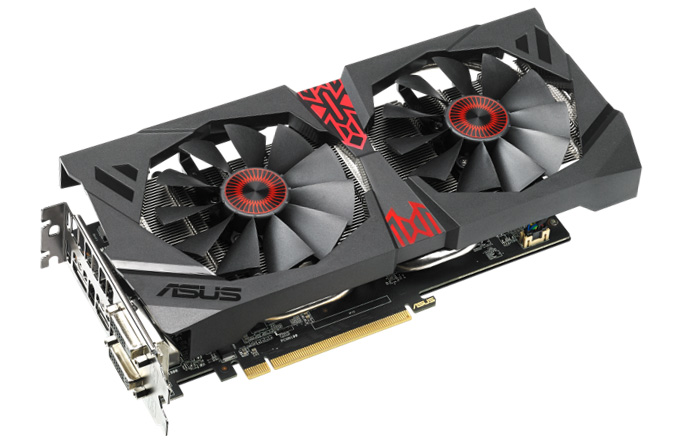
Back in September of 2014 AMD released their first Graphics Core Next 1.2 GPU, Tonga, which was the GPU at the heart of the Radeon R9 285. For all intents and purposes Tonga was the modern successor to AMD’s original GCN GPU, Tahiti, packing in the same 32 CUs and 32 ROPs, while other features such as color compression allowed AMD to trim the memory bus to 256-bits wide without a performance hit. With Tahiti slowly going out of date from a feature perspective, Tonga was an interesting and unprecedented mid-cycle refresh of a GPU.
However in the 14 months since the launch of the first Tonga product AMD has never released a fully enabled desktop SKU, until now. Radeon R9 285 utilized a partially disabled Tonga – only 28 of 32 CUs were enabled – and while it was refreshed as the Radeon R9 380 as part of the Radeon 300 series launch, a fully enabled version of Tonga only showed up in mobile, where in the form of the R9 M295X it was used in the 27” iMac. In its place AMD continued selling the Tahiti based Radeon R9 280 series for much longer than we would have expected, leading to an atypical situation for AMD where a card using the fully enabled GPU is only now showing up over a year later. In some ways Radeon R9 380X is a card we were starting to think we’d never see.
But at last a full-featured Tonga is here as the heart of AMD’s latest video card, the Radeon R9 380X. AMD is launching the 380X at this time to setup their product stack for the holidays, looking to shake up the market shortly before Black Friday and dig out a spot in the gap between NVIDIA’s GeForce GTX 970 and GTX 960 cards. By hitting NVIDIA a bit above the ever-popular $200 spot, AMD is aiming to edge out NVIDIA on price/performance while also snagging gamers looking to upgrade from circa 2012 video cards.
| AMD GPU Specification Comparison | ||||||
| AMD Radeon R9 390 | AMD Radeon R9 380X | AMD Radeon R9 380 | AMD Radeon 280X | |||
| Stream Processors | 2560 | 2048 | 1792 | 2048 | ||
| Texture Units | 160 | 128 | 112 | 128 | ||
| ROPs | 64 | 32 | 32 | 32 | ||
| Boost Clock | 1000MHz | 970MHz | 970MHz | 1000MHz | ||
| Memory Clock | 6Gbps GDDR5 | 5.7Gbps GDDR5 | 5.5Gbps GDDR5 | 6Gbps GDDR5 | ||
| Memory Bus Width | 512-bit | 256-bit | 256-bit | 384-bit | ||
| VRAM | 8GB | 4GB | 2GB | 3GB | ||
| FP64 | 1/8 | 1/16 | 1/16 | 1/4 | ||
| TrueAudio | Y | Y | Y | N | ||
| Transistor Count | 6.2B | 5.0B | 5.0B | 4.31B | ||
| Typical Board Power | 275W | 190W | 190W | 250W | ||
| Manufacturing Process | TSMC 28nm | TSMC 28nm | TSMC 28nm | TSMC 28nm | ||
| Architecture | GCN 1.1 | GCN 1.2 | GCN 1.2 | GCN 1.0 | ||
| GPU | Hawaii | Tonga | Tonga | Tahiti | ||
| Launch Date | 06/18/15 | 11/19/15 | 06/18/15 | 10/11/13 | ||
| Launch Price | $329 | $229 | $199 | $299 | ||
Starting as always from a specification comparison, the R9 380X is going to be a very straightforward card. Rather than R9 380’s 28 CUs, all 32 CUs are enabled for R9 380X. As this was the only thing disabled on R9 380, this means that the increased stream processors and texture resources are the only material GPU change as opposed to the R9 380. Otherwise we’re still looking at the same 32 ROPs backed by a 256-bit memory bus, all clocked at 970MHz.
Meanwhile as far as memory goes, the R9 380X sees AMD raise the default memory configuration from 2GB for the R9 380 to 4GB for this card. We’ve reached the point where 2GB cards are struggling even at 1080p – thanks in large part to the consoles and their 8GB of shared memory – so to see 4GB as the base configuration is a welcome change. R9 380 did offer both 2GB and 4GB, but as one might expect, 2GB was (and still is) the more common SKU that for better or worse makes R9 380X stand apart from its older sibling even more. Otherwise the 5.7Gbps memory clockspeed of the R9 380X is a slight bump from 5.5Gbps of the 2GB R9 380, though it should be noted that 5.7Gbps was also the minimum for the 4GB R9 380 SKUs. So in practice just as how there’s no increase in the GPU clockspeed, there’s no increase in the memory clockspeed (or bandwidth) with 4GB cards.
Similarly, from a power perspective the R9 380X’s typical board power remains unchanged at 190W. In practice it will be slightly higher thanks to the enabled CUs, but otherwise AMD hasn’t made any significant changes to shift it one way or another.
From a performance perspective then the R9 380X is not going to be a very exciting card. After 3 releases of the fully enabled Tahiti GPU – Radeon 7970, 7970 GHz Edition, and R9 280X – the architectural and clockspeed similarities of R9 380X mean that it’s essentially a fourth revision of this product. Which is to say that you’re looking at performance a percent or two better than the 7970, well-tread territory at this point.
The R9 380X’s principle reason to exist at this point is to allow AMD to refresh their lineup by tapping the rest of Tonga’s GPU performance, both to have something new to close out the rest of the year and to give them a card that can sit solidly between NVIDIA’s GeForce GTX 970 and GTX 960. That AMD is launching it now is somewhat arbitrary – we haven’t seen anything new in the $200 to $500 range since the GTX 960 launched in January and AMD could have launched it at any time since – and along those lines AMD tells us that they haven’t seen a need to launch this part until now. With the R9 380 otherwise shoring up the $199 price point until more recently, there’s always a trade-off to be had with having better positioning than the competition versus having too many products in your line (with the 300 + Fury series the tally is now 9 cards).
In AMD’s new lineup the R9 380X will slot in between AMD’s more expensive R9 390 and the cheaper R9 380. AMD is promoting this card as an entry-level card for 2560x1440 gaming, though with the more strenuous games released in the last 6 months that is going to require some quality compromises to achieve. As it stands I’d consider the 390 more of a 1440p card, while the R9 380X is better positioned as AMD’s strongest 1080p card; only in the most demanding games should the R9 380X face any real challenge.
| AMD Relative Benchmark Performance (1080p) | |||||
| Card | Performance | Price | |||
| Radeon R9 390 | 157% | $289 | |||
| Radeon R9 380X | 110% | $229 | |||
| Radeon R9 380 (2GB) | 100% | $179 | |||
| Radeon R9 370 | 78% | $129 | |||
| Radeon HD 7850 | 63% | N/A | |||
As far as performance goes then, the R9 380X is about 10% faster than the 2GB R9 380 at 1080p, with the card taking a much more significant advantage in games where 2GB cards are memory bottlenecked. Otherwise the performance is almost exactly on-par with the 7970 and its variants, while the more powerful R9 390 has a sizable 43% performance advantage thanks to its greater CU count, memory bandwidth, and ROPs. This makes the R9 390 a bit of a spoiler on value, though its $290+ price tag ultimately puts it in its own class. Or to throw in a quick generational comparsion to AMD's original $250 GCN card, Radoen HD 7850, you're looking at a 75% increase in performance at this price bracket over 3 years.
Today’s launch of the R9 380X is a hard launch, with multiple board partners launching cards today. For most of the partners they will be reusing their R9 380 designs, which is fitting given the similarities between the two cards. Expect to see a significant number of factory overclocked cards, as Tonga has some headroom for the partners to play with. OC cards will start at $239 – a $10 premium – while the card we’ve been sampled from AMD, ASUS’s STRIX R9 380X OC, will retail for $259.
As for the competition, as I previously mentioned AMD will be slotting in between the GeForce GTX 970 and GTX 960. The former is going to be quite a bit faster but also quite a bit more expensive, while the R9 380X will handily best the 2GB GTX 960, albeit with a price premium of its own. At this point it’s safe to say that AMD holds a distinct edge on performance for the price, as they often do, though as has been the case all this generation they aren’t going to match NVIDIA’s power efficiency.
Finally, on a housekeeping note we’ll be back on Monday with a review of the ASUS STRIX R9 380X alongside a look at performance at reference clocks. We’ve only had the card and AMD’s launch drivers since the beginning of this week and there is still some work to be done before we can publish our review, so stay tuned.
| Fall/Winter 2015 GPU Pricing Comparison | |||||
| AMD | Price | NVIDIA | |||
| Radeon R9 Fury | $529 | ||||
| $469 | GeForce GTX 980 | ||||
| Radeon R9 390X | $379 | ||||
| Radeon R9 390 | $289 | GeForce GTX 970 | |||
| Radeon R9 380X | $229 | ||||
| Radeon R9 380 | $179/$169 | GeForce GTX 960 | |||
| $149 | GeForce GTX 950 | ||||
| Radeon R9 370 | $129 | ||||


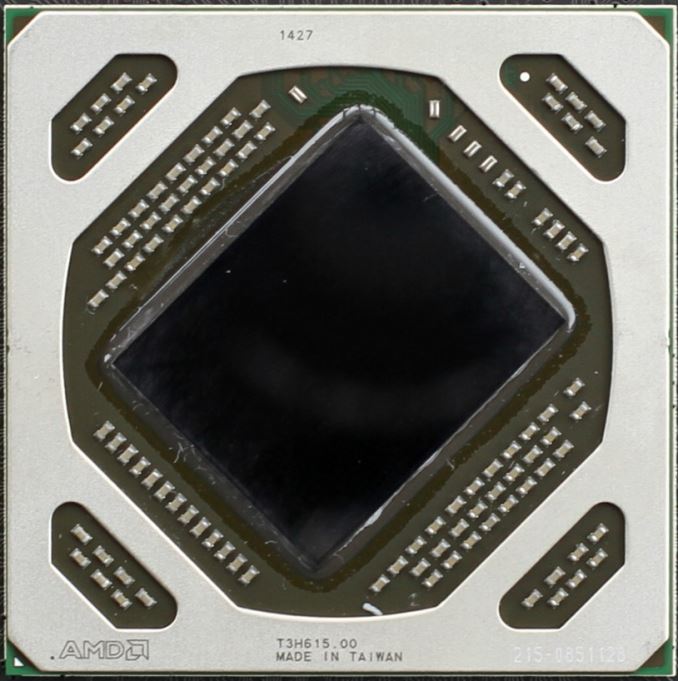
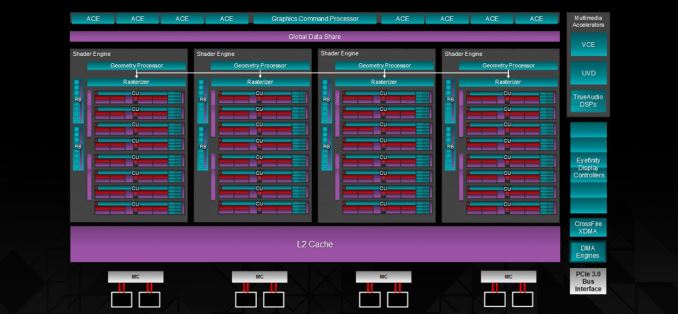
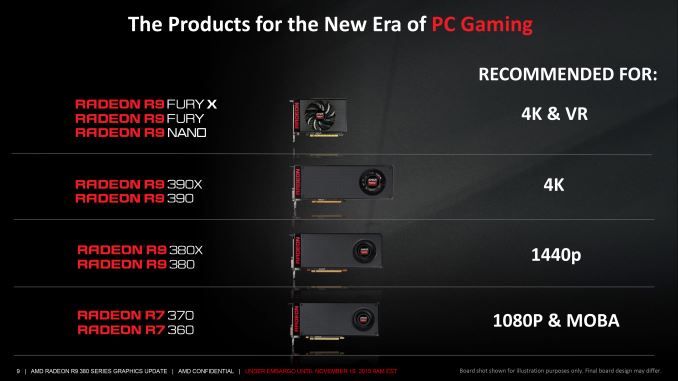
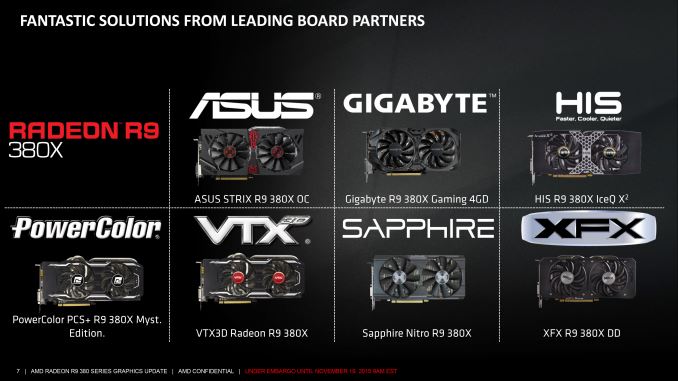








52 Comments
View All Comments
jardows2 - Thursday, November 19, 2015 - link
Looking forward to product benchmarks. I jumped and bought a 285 a few months ago on a good sale with an additional $30.00 rebate. Made my card about $70.00 cheaper than the 380x, but I would love to see the actual numbers on the performance difference. Please, when you bench these, make sure the 285 is thrown in the mix!Flunk - Thursday, November 19, 2015 - link
the 380 and 285 are functionally the same, so the 380x should be about 10% faster (According to this article).Samus - Thursday, November 19, 2015 - link
The problem is the 10% performance increase comes at a 30% price increase. Unless this card is $200 I don't see it being worth it. I mean just spend $50 more and get the 390 which is substantially faster.T1beriu - Thursday, November 19, 2015 - link
The VRAM also doubles to 4GB.drwhoglius - Thursday, November 19, 2015 - link
"That AMD is launching it now is somewhat arbitrary – we haven’t seen anything new in the $200 to $500 range since the GTX 960 launched in January and AMD could have launched it at any time since – and along those lines AMD tells us that they haven’t seen a need to launch this part until "<20% dGPU market share in back to back quarters isn't arbitrary
http://jonpeddie.com/publications/add-in-board-rep...
DanNeely - Thursday, November 19, 2015 - link
My guess would be that the delay was yield related. There's no reason not to offer a full die model at or shortly after launch unless you're not getting enough perfect chips to meet demand.drwhoglius - Thursday, November 19, 2015 - link
Nvidia has had no problem supplying massive numbers of GM204 and GM206 based cards into the channel, I'd be surprised if AMD wasn't having extraordinarily high yields right off the bat. I suspect the reason may be financial, Tonga has a much larger die than the GM206 it just edges out performance wise and margins may be so tight they're willing to cede market share in this segment.testbug00 - Thursday, November 19, 2015 - link
It's not a yield issue.It probably has to do with originally they didn't launch because to many 280x in the channel. Than after those mostly got cleared out they could wait a few months and pull in some extra dollars using the 380. Which launched at $200 for 2GB and about 230 for 4GB.
The fact that the 380 is the fastest card until you get up to the 970/390 hence AMD has no competition there also made a delay entirely possible.
drwhoglius - Thursday, November 19, 2015 - link
I generally agree with "there's no bad product, just bad pricing" but Tonga appears out of position in the market and that may be part of why this product hasn't launched until now as a gap may not exist. The GTX 960 is the value leader in the cut-throat <$200 1080p gaming market (and shooting up the Steam survey charts) while the marginal performance improvements offered by the 285/380 make the slightly higher price and power requirements difficult for consumers to justify.The 1440p branding is truly wishful thinking even with the fully enabled die of the 380X, gaming consumers who spend $300-700 on a 1440p display aren't terribly price sensitive and won't pair it with anything below a 970/390 GPU
medi03 - Friday, November 20, 2015 - link
280x is about 15-20% faster than 960, while being on par in power consumption (e.g. 229w vs 199w total power in Metro Last Night)http://www.hardwareheaven.com/2015/11/xfx-amd-rade...
380 is about 10% faster, plus nice additions like FreeSync (no, GSync doesn't compare to it, as monitors are also more expensive) that is hardly "marginal".